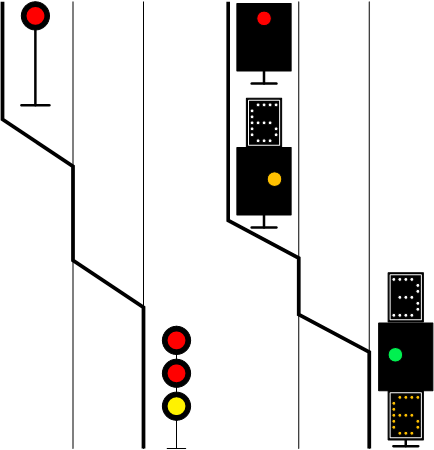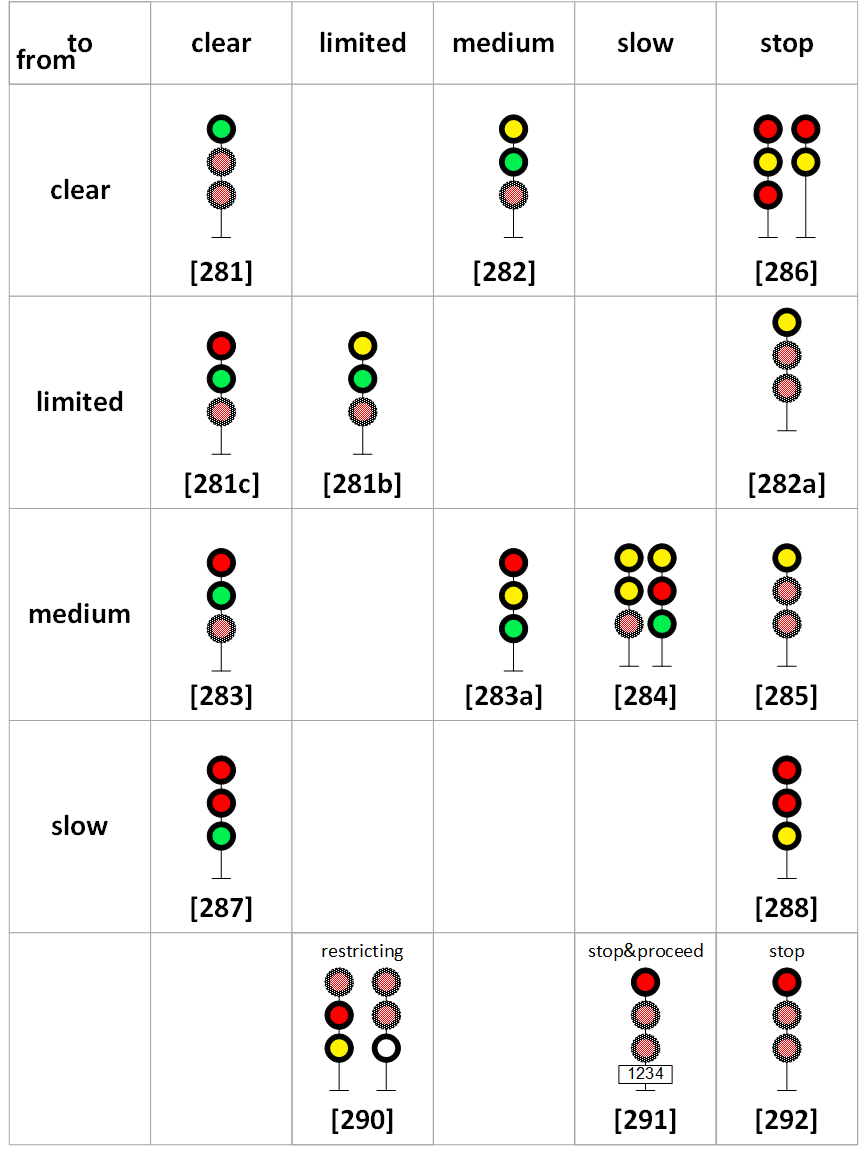
For a European, North American colour light signals seem to be a collection of up to three lights that can display any possible combination of colours and flashing lights - without making too much sense.
Well, if you look at the fact that almost every railway company has at least one signal system, or more than one if it is a merger, and that there are things that they call position light signals, which can display colourful lights (while the colour has no meaning, just the arrangement of lights), you start wondering.
But then you learn that a basic rule is "if it's not all red, it's not red at all1", i.e. other than the European convention that a red is stop and never anything else, in North America a red in many cases is just the colour used if a light has nothing useful to display.
In other words, red is the colour that a lantern shows to display
"disregard me - I'm
not really here", you stop wondering and conclude that their signals
don't make sense
at all (except keeping anyone below Einstein's IQ from passing the
drivers test).
Now, if you take a deeper look, some things in fact make
(some) sense, and here I will
explain what I think is the secret. (If everything would make sense, it
wouldn't be American)
As examples on this I use the aspects and rules as used by the
Northeast Operating Rules Advisory Committee (NORAC). On another page I
analyze the Canadian
railways' signals (CROR-Canadian
Railway Operating Rules) which, despite using dummy reds, make a bit
more sense.
Before we dive deeper into the shady waters of American signalling, let me point out a few differences to European signalling (remember, this is a German site and I look at signalling from a European perspective).
In the USA, the distances are much longer than in Europe. So e.g. there is an aspect (NORAC rule 288), stating: "Slow Approach: Proceed prepared to stop at the next signal. Slow Speed applies until entire train clears all interlocking or spring switches, then Medium Speed applies." This rule effectively states three different speeds (slow, then medium, then expect stop), while in Europe, due to shorter distances between points, signals, and other things, we would have two multiple-block signals in place: The first would say "clear with 30 km/h, expect clear with 60 km/h", the second signal would say "clear with 60 km/h, expect stop", the second signal being at braking distance to the last signal (which is at stop).
See this example for how rule 288 would be signalled in Germany, using Ks signals.
"
In the table below, the lanterns that are displayed in dimmed colours may be absent. For the aspects that have a red on top, remember that before points, the British used to have semaphores with different heights, the higher one for the straight track and lower ones for diverging tracks. So if a diversion was to be announced, the driver would see a red on top, and to the lower side a green. This system is similar, although the British signals carry no speed information but are route signals.
An amber on top (or green over red, not shown in the table) tells you that the current speed is clear, and the next signal will show clear with a speed limit (but neither clear nor stop).
A red on top tells you that the current speed is not maximum. The speed after this signal is given by the first non-red lantern, and the next signal's indication is shown by the lamp farthest down, unless the next signal show clear or stop.
In the former cases, a green indicates medium speed, a flashing green indicates limited speed, and a flashing amber indicates slow speed. Examples: red-flashing green-green means "limited to medium".
Exceptions are the indications "something to clear" and
"something to
stop".
When the next signal shows clear, the third lamp is red (:-0) (so here
red means
"expect clear", and this page's caption seems to become true...), or in
the case
of "slow to clear" the aspect is shown using the second and third lamp,
if a top
lamp is present displaying the "filler red", the aspect becomes
red-red-green.
When the next signal is at stop, the same aspect as for expect clear is
used, just using
an amber instead of the green, which makes it incompatible with the
other aspects. You got
that? (It took me a number of sheets of paper and a bunch of brain
cells)
So most of the aspects seem to make sense, although the use of a red lantern for either showing "I'm not here" or "expect clear" is something that would take some time to get used to...

Signals can have one or multiple heads, and the rule is that no head must ever be completely dark. As example, a signal with three lamps may have one or three heads. So the aspect "clear, expect stop" is shown by one amber light if the signal has one head, if it has more than one, e.g. two or three, the bottom head(s) display red:
 |
 |
 |
 |
| all these say "clear, expect stop" | |||
Ah yes, since it would be too easy just to tell the speed by
numbers, they call the
speeds names: Instead of just saying 24 km/h,
48 km/h, or 72 km/h they say
things like "slow", "medium", or "limited speed".
By the way, "restricted speed" is about the same speed as "slow", just
be on the watch and prepared to brake short of other vehicles in your
track, so according
to European usage a "restricted speed" is not a speed signal but some
sort of
caution signal.
So, now I still haven't answered whether it all makes sense. Well, not everything on the wrong side of the pond makes sense, but if you're ready to drop European views and perspectives: Yes, it does make sense. (Uh, it did, before the exceptions were invented). So then proceed to Part II:
1) "If it's not all red, it's not red at all", see on Mike Roqués's site about understanding railway signals.
 home home |
 Non-DB signals Non-DB signals |
 email email |
 Canadian
Signals Canadian
Signals |
 US Signals,
Part II US Signals,
Part II |